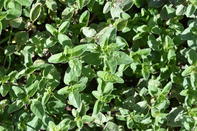
Scientific name: Origanum vulgare
Common Name: Oregano or Origanum
Oregano originates from Southern Europe and Mediterranean North Africa.
Plant Description
The Oregano plant is a hardy perennial that grows to about 500 mm in height and has a grey-green leaf. The plant produces numerous side branches from which the leaves develop. The flowers that form on the tips of the branches are either white, which produce the most essential oil, or pink and purple, which is used mainly for culinary purposes.Uses
Oregano in both its fresh and dried form is used in many food dishes as a flavouring. The other use is for the production of essential oils. The essential oil is used both externally and internally for its antimicrobial properties. It is said to treat Candida, athlete’s foot and relieve irritation from insect bites and can also be used as an insect repellent.Soil Requirements and Preparation
Oregano grows best in a well-drained sandy loam soil with a pH of between 6.5 and 7.5. Before any soil preparation is done a representative soil sample should be taken and sent to a laboratory for analysis and nutrient recommendations. Soils should be ripped to loosen the soil profile to about 500 mm to ensure good drainage. Rectify pH levels by adding lime.
The manure or compost should be applied and ploughed into the top 400 mm of soil about four to five weeks before planting. In the final days before planting add trace elements and a balanced pre-plant fertilizer to the soil, then disc harrow into the top 20 cm of soil. This will also clear any weeds that may have established. Install irrigation and mulching if required.
Climate
Oregano is a hardy evergreen plant that grows in warm Mediterranean climates and performs best in temperatures of between 16°C and 28°C. It is also tolerant to frost. Soil temperatures should be above 12°C for good germination or establishment of seedlings.Cultivars
There are two main types of oregano produced commercially. The selection of clones has only recently been given priority since the value of the essential oil has driven commercial production.
The pink and purple flower subspecies is used mostly for culinary purposes and the white flower type used mainly for the higher essential oil yield. Some varieties available are: Aureum, Crispum, Country cream, Dark leaf, Gold tip, Nanum, Variegata and Zorba.
There are many other varieties and it is as always best practice to get the advice of the local extension officer and seed specialists for the best variety for the production area and target market.
By Louise Brodie